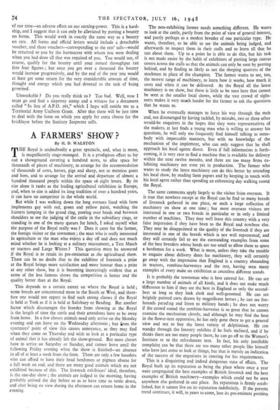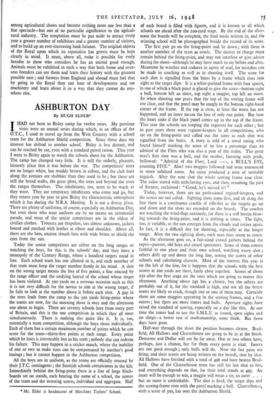A FARMERS' SHOW?
By H. D. WALSTON
THE Royal is undoubtedly a great spectacle, and, what is more, is magnificently stage-managed. It is a prodigious effort to lay out a showground covering a hundred acres, to allot space for thousands of pieces of machinery, to arrange for the accommodation of thousands of cows, horses, pigs and sheep, not to mention goats and bees, and to arrange for the arrival and departure of almost a hundred thousand people within the space of- eight hours. By its size alone it ranks as the leading agricultural exhibition in Europe, and, when to size is added its long tradition of over a hundred years, it can have no competitor in the whole world.
But while I was walking down the long avenues lined with farm implements gay with red, green and yellow paint, watching the hunters jumping in the grand ring, peering over heads and between shoulders to see the judging of the cattle in the subsidiary rings, or standing in one of the many queues for lunch, I asked myself what the purpose of the Royal really was ? Does it cater for the farmer, the foreign visitor or the townsman ; the man who is really interested in agriculture or the man who enjoys a day off and does not much mind whether he is looking at a military tournament, a Test Match or tractors and Large Whites ? This question must be answered if the Royal is to retain its pre-eminence as the agricultural show. There can be no doubt that to the exhibitor of livestock a prize at the Royal brings more satisfaction and more honour than a prize at any other show, but it is becoming increasingly evident that at some of the less famous shows the competition is hotter and the quality better than at the Royal.
This depends to a certain extent on where the Royal is held ; some breeds are concentrated more in the South or West, and there- fore one would not expect to find such strong classes if the Royal is held at York as if it is held at Salisbury or Reading. But another factor which discourages the breeder from showing at the Royal is the length of time the cattle and their attendants have to be away from home. In a few classes animals need only arrive on the Monday evening and can leave on the Wednesday afternoon ; but grom the spectators' point of view this causes annoyance, as they may find when they come on Thursday and wish to look at a particular type of animal that it has already left the show-ground. But most classes have to arrive on Saturday or Sunday, and cannot leave until the following Friday evening when the show is finished—an absence in all of at least a week from the farm. There are only a few breeders who can afford to have their head herdsmen or pigmen absent for a full week on end, and there are many good animals which are not exhibited because of this. The livestock exhibitors' ideal, therefore, is the one-day show ; the animals are judged in the morning, having probably arrived the day before so as to have time to settle down, and after being on view during the afternoon can return home in the evening. The non-exhibiting farmer needs something different. He wants to look at the cattle, partly from the point of view of general interest, and partly perhaps as a modest breeder of one particular type. He wants, therefore, to be able to see the animals being judged, and afterwards to inspect them in their stalls and to learn all that he can about them. Up to a point he is able to do this, but his task is not made easier by the habit of exhibitors of putting large canvas covers across the stalls so that the animals can only be seen by peering behind, and by finding as likely as not the sleeping quarters of the stockman in place of the champion. The farmer wants to see, too, the newest range of machinery, to learn how it works, how much it costs and when it can be delivered. At the Royal all the latest machinery is on show, but there is little to be seen here that cannot be seen at the smaller local shows, while the vast crowd of sight- seers makes it very much harder for the farmer to ask the questions that he wants to.
When he eventually manages to force his way through the mob and, not discouraged by having tackled, by mistake, two or three other would-be enquirers in the hopes that they were representatives of the makers, at last finds a young man who is willing to answer his questions, he will only too frequently find himself talking to some- body with impeccable manners, but with no knowledge of the mechanism of the implement, who can only suggest that he shall approach his local agents direct. Even if full information is forth- coming, it is very rare to find a machine that is available for delivery within the next twelve months, and there are too many firms ex- hibiting machinery not even yet in production. The farmer who wants to study the latest machinery can do this better by attending his local show, by reading farm papers and by keeping in touch with his local agent rather than spending an exhausting day walking round the Royal.
The same comments apply largely to the visitor fnim overseas. It is true that nowhere except at the Royal can he find so many breeds of livestock gathered in one place, or such a large collection of machinery on show at one time ; but most overseas visitors are interested in one or two breeds in particular or in only a limited number of machines. They may well leave this country with a very false impression if they have been to the Royal and nowhere else. They may be disappointed at the quality of the livestock if they are interested in one of the breeds which is not well represented, and they will certainly fail to see the outstanding examples from some of the best breeders whose herds are too small to allow them to spare a herdsman for a week. What is more, unless they take the trouble to enquire about delivery dates for machinery, they will certainly go away with the impression that England is a country abounding in tractors, combine-harvesters and the rest, having seen many examples of every make on exhibition at countless different stands.
It is probably the townsman who is best catered for. He can see a large number of animals of all kinds, and it does not make much °difference to him if they are the best in England or only the second- best so long as they look sleek and well-groomed. He can see brightly painted carts drawn by magnificent horses ; he can see fox- hounds parading and listen to military bands ; he does not worry if the crowd round the combine-harvester is so great that he cannot examine the mechanism closely, and although he may find the heat in the flower-tent oppressive, he has only gone there to get a general view and not to buy the latest variety of delphinium. He can wander through the forestry exhibits if he feels inclined, and if he thinks there are too many people there, he can go off to the Women's Institute or to the refreshment tent. In fact, his only justifiable complaint can be that there are too many other people like himself who have just come to look at things, but that is merely an indication of the success of the organisers in catering for his requirements.
This is a disquieting and indeed dangerous state of affairs. The Royal built up its reputation as being the place where once a year were congregated the best examples of British livestock and the best examples of British machinery—examples which could not be seen anywhere else gathered in one place. Its reputation is firmly estab- lished, but it cannot live on its reputation indefinitely. If the present trend continues, it will, in years to come, lose its pre-eminent position
among agricultural shows and become nothing more nor less than a fine spectacle—but one of no particular significance to the agricul- tural industry. The temptation must be put aside to attract every year a greater number of exhibitors and a greater number of visitors, and to build up an ever-increasing bank balance. The original objects of the Royal upon which its reputation has grown must be kept clearly in mind. It must, above all, make it possible for every breeder to show who considers he has an animal good enough. Animals must be exhibited in such a way that both home and over- seas breeders can see them and learn their history with the greatest possible ease ; and farmers from England and abroad must feel that by going to the Royal they can hear of developments and see machinery and learn about it in a way that they cannot do any- where else.



































 Previous page
Previous page